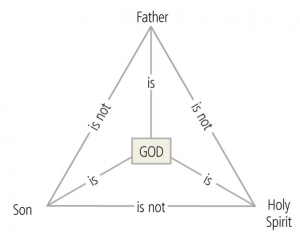Once again, when we say “Jesus is God,” we are not saying “Jesus is the Father” or “Jesus is the Spirit” (both are called “God”; see Acts 5:3-4 & Col 1:2). How can God be each of these distinctly? Consider the diagram:
What this shows is that, while there are three persons in the Trinity, there is still only one God. Scripture clearly affirms this truth (read last week’s article).
As the nature of God is progressively revealed in Scripture, the one God is seen to exist eternally in three persons. These three persons share the same divine nature yet are different in role & relationship. The basic principle at the heart of God’s triune being is unity and distinction, both coexisting without either being compromised. Anything that is necessarily true of God is true of Father, Son & Spirit. They are equal in essence yet distinct in function.
Think of it like this: While equal in nature but distinct in role and relationship, the distinct roles typically have the Father willing, the Son accomplishing & the Spirit applying the work of the Son. Each are clearly at work in the key events throughout salvation’s history, including the creation, Christ’s incarnation & resurrection, human regeneration, the inspiration & illumination of Scripture, & the believer’s sanctification.
In fact, the doctrine of the Trinity is most fully realized in the NT where the divine Father, Son & Spirit are seen accomplishing redemption. That is what we will look at specifically next week so that we have a clear example of this amazing truth at work! Get ready!





